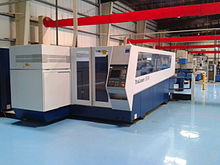Lasers are a reliable and efficient tool for cutting metal and are commonly used in the metal fabrication and production markets. They are most efficient, however, when integrated with CNC machining.

Laser cutting works by focusing a high-powered laser onto the surface of the metal, usually focused through an optical system. The material is then gotten rid of by being charred, vaporized, or blown away as a jet of gas, leaving a specifically cut edge and a high quality surface area finish. Industrial lasers are utilized to cut tubes and pipelines along with flat sheet material.
How Lasers Work
A laser beam is created by promoting a lasing material with electrical discharges included within a closed container. The cutting section of the beam is very fine, generally less them 0.32 mm in diameter.
Advantages Of Using CNC Machining Lasers
The advantages of utilizing lasers to cut metal rather mechanical cutting processes include:
– It is easier to keep the work-piece in location – mechanical cutting applies different forces that imply the piece needs to be solidly secured to keep it consistent.
– Reduced contamination – as there is no swarf, cooling fluid or external blade that can use and leave deposits, it is a much cleaner process.
– Better accuracy – physical blades use and this can affect the line of their cut. Lasers are no impacted this way and the cutting point does not vary.
– Reduced possibility of warping – as there is no drag of a blade through the material, and the hot cutting point is really localised, contortion from mechanical forces is avoided.
– Intricate cuts are also possible – mechanical blades are restricted in their ability to alter instructions.
– Lasers are more precise and utilize less energy than plasma cutters.
When combined with the control used by CNC machining, lasers can cut complicated shapes and designs quickly and properly. This makes them ideal for numerous metal fabrication jobs such as cutting profiles and internal structures for equipment.
Types of Lasers
There are 3 primary kinds of lasers used for metal-cutting:
CO 2 Laser – Suitable for cutting, dull and engraving.
Nd lasers are perfect for dull and when high energy but low repetition are required. All the types of laser are used for welding.
CO 2 lasers are utilized in numerous commercial cutting processes and the products they are used for cutting consist of mild steel, aluminium, stainless steel and titanium.
The lasers themselves produce a high degree of heat and need cooling. Depending upon the size and configuration of the system, the waste heat generated throughout operation might be transferred by a coolant or straight to air. Water is often used as a coolant, normally flowed through a chiller or heat transfer arrangement.
There are likewise 2 other kinds of laser, although these are less typical in metal fabrication.
Laser Microjet – this is a laser that is guided by a water-jet. The laser beam is pulsed into a low-pressure water jet that is utilized to assist the laser beam, as if it were an optical fiber.
Fiber Lasers – this is a solid state laser that uses a solid gain medium, rather than a liquid or a gas. The system is arranged so that a seed laser beam is magnified inside the glass fiber.
Laser cutting works by focusing a high-powered laser onto the surface of the metal, normally focused through an optical system. Industrial lasers are utilized to cut pipes and tubes as well as flat sheet material.
All the types of laser are utilized for welding.
Laser Microjet – this is a laser that is directed by a water-jet. The laser beam is pulsed into a low-pressure water jet that is utilized to guide the laser beam, as if it were an optical fiber.